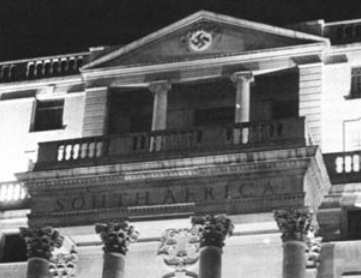The future of fascism
Since the collapse of actually existing socialism and the abrupt ending of the Cold War that had polarized the world along the lines of contending theories of modernization, there has been a steady attempt to recover historical intensities that had been displaced by the reduction of political differences to a dyadic struggle between ʻtotalitarianismʼ and the ʻfree worldʼ. Almost as if the flood gates had been lifted, the suppressed experiences of a prior age have been unleashed into the new time announced by the post-Cold War, reminding the present that the past had not really disappeared so much as been shelved in our midst, a little like a purloined letter we have faced without recognizing it in its place. One of the more important casualties of this silencing and banishment was the fate of fascism, as both a powerful ideological force in the 1930s and a political movement that swept rapidly over whole continents. This is not to suggest that throughout the years of the Cold War the subject was ignored, but its understanding was mediated by its association with the category of totalitarianism. With the ending of the Cold War, fascism was released from its singular association with totalitarianism and the way was reopened to focus on its relationship to capitalist modernization, if not to induce occasional pangs of nostalgia for the 1920s and 1930s.
 The turn to reassessing the status of fascism has been prompted less by a desire to perform a historiographical finger exercise than the need to find an optic capable of grasping the contemporary situation, in which the familiar signs of fascism have begun to show themselves with greater regularity. The appearance of three books,* within a year or so of each other, demonstrates a desire to ʻwork through a pastʼ in order to avoid both the risk of caricature and the forgetting of objective social conditions that identify the continuing persistence of fascist spectres. Paxton and Wolin both agree with Michael Mannʼs declared aim ʻto take fascism seriouslyʼ, as if to compensate for a weakened memory that more often than not inhibited the effort to work through the traces of this shelved history. These books seek to show that even though fascism had its epochal moment, its history is not nearly completed in light of the contemporary conjuncture and the turn of events since 9/11. Lurking behind this renewed interest, then, is the fearful conviction that a political catastrophe threatens to repeat itself in a different register and that the past of fascism might yet prefigure our future and take reprisals on it, since it has not yet been sufficiently worked through.
The turn to reassessing the status of fascism has been prompted less by a desire to perform a historiographical finger exercise than the need to find an optic capable of grasping the contemporary situation, in which the familiar signs of fascism have begun to show themselves with greater regularity. The appearance of three books,* within a year or so of each other, demonstrates a desire to ʻwork through a pastʼ in order to avoid both the risk of caricature and the forgetting of objective social conditions that identify the continuing persistence of fascist spectres. Paxton and Wolin both agree with Michael Mannʼs declared aim ʻto take fascism seriouslyʼ, as if to compensate for a weakened memory that more often than not inhibited the effort to work through the traces of this shelved history. These books seek to show that even though fascism had its epochal moment, its history is not nearly completed in light of the contemporary conjuncture and the turn of events since 9/11. Lurking behind this renewed interest, then, is the fearful conviction that a political catastrophe threatens to repeat itself in a different register and that the past of fascism might yet prefigure our future and take reprisals on it, since it has not yet been sufficiently worked through.
Forgetting fascism
Let me begin by recalling Hannah Arendtʼs epochal study, The Origins of Totalitarianism (1951), issued not long after the inauguration of the Cold War. It initiated the long-standing tendency to reduce fascism and communism to their shared, minimal dimensions by referring to both as expressions of totalizing political forms – different sides of the same coin – committed to state violence on a genocidal scale. Coupling Stalin and Hitler became a favourite reflex of the Cold War, drawing upon the experience of Germany and Italy to dramatize fascismʼs urge to realize total reorganization and Soviet Russia to personify the communist analogue. Both shared a genocidal impulse driven by the necessity of realizing a totalizing political ambition. But what Arendt dropped from her new equation was the role played by vitalism in the 1930s and its relationship to fascism. This is still important because vitalism (excoriated by Georg Lukács in his underappreciated The Destruction of Reason, 1952), signified, in its full fury, the end of civilization and culture altogether, and was joined at the hip with the desire of totalitarianism to perpetuate the loss of freedom in self-estrangement and unreality. In fact, in the 1930s, vitalism and totalitarianism were seen as opposing forces, with the former standing for the preconscious, changeless and ahistorical, while the latter signified post-consciousness and the post-historical. Furthermore, to link socialism, even the Stalinist inflection of a distorted Marxism, to cultural nihilism and a frenzied Spenglerian civilizational dance of death worked […]
⤓ Click here to download the PDF of this item